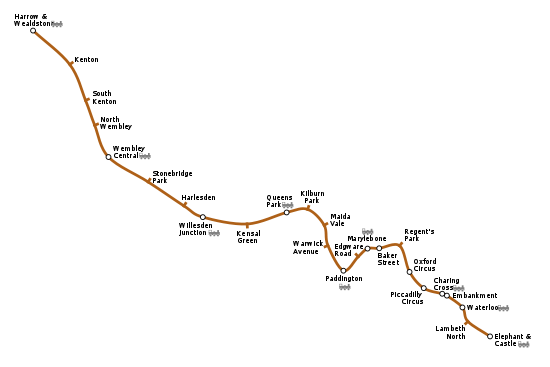Marylebone station
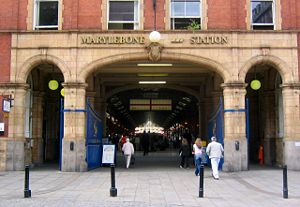 |
|
| Location | Marylebone |
|---|---|
| Local authority | Westminster |
| Managed by | Chiltern Railways |
| Station code | MYB |
| Platforms in use | 6 |
| Travelcard zone | 1 |
| NR 2004/5 usage | 6.949 million[1] |
| NR 2005/6 usage | 6.819 million[1] |
| NR 2006/7 usage | 11.639 million[1] |
|
|
|
| 1899 1966 1996 2006 2008 |
Opened GCML beyond Aylesbury closed Birmingham services begin Two new platforms built Services to Wrexham begin |
|
|
|
| List of stations | Underground • National Rail |
| External links | Departures • Facilities |
|
|
|

Marylebone station or London Marylebone station is a National Rail and London Underground station in central London, England. The station is located midway between the mainline stations at Euston and Paddington, about 1 mile (1.6 km) from each.
Opened in 1899, it is the youngest of London's mainline terminal stations, and also one of the smallest, with it opening with half of the platforms that it was originally envisaged to have. It is also the only terminal station in London without electrified platforms, meaning that for many years it was only served by diesel multiple units. Locomotive-hauled services have recently returned (to Wrexham), and sometimes special services hauled by diesel or steam locomotives also travel to Marylebone.
The station, despite its small size and catchment area in comparison to other London terminals, has recently undergone an expansion in the number of platforms, increasing the number of passengers using the terminal. It is in Travelcard Zone 1.
Contents |
Location
The station is located just off Marylebone Road, in Marylebone, London. This road is major road feeding the A40 (and thus the M40 motorway), the A41 and A5 (and thus the M1 motorway). Nearby attractions include Regents Park, Lord's Cricket Ground, Baker Street and Madame Tussauds.
National Rail
The mainline station has six platforms; two originally built in 1899, two inserted into the former carriage road, and two built in September 2006. It is no longer the smallest of the railway terminals in London, although apart from the now defunct Waterloo International (replaced by the terminus at St Pancras Station, which opened in November 2007) it remains the newest. It is the only non-electrified terminal in London. Marylebone is operated by Chiltern Railways, making it almost unique amongst London's terminal stations as only one of two not to be managed by Network Rail, the other being London Blackfriars, which is managed by First Capital Connect.
Train services into the station are run by Chiltern Railways which serves the Chiltern Main Line and London to Aylesbury Line routes to High Wycombe, Aylesbury, Bicester, Banbury, Leamington Spa, Stratford-upon-Avon, Birmingham (Snow Hill), and Kidderminster.
Marylebone is also served by 5 trains per day to Wrexham via the Midlands and Shropshire. These are operated by the Wrexham, Shropshire & Marylebone Railway.
Around 11.6 million passengers passed through Marylebone between 2006/2007, an increase of 4.8 million passengers since 2005/2006 working out to a 70% uasge rise in just a year. This makes it London fastest growing passenger rail terminal by percentage growth rate.
History
Pre 1958 - GCR and LNER
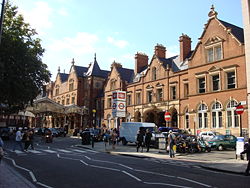
The station was opened on the 15th of March 1899[2] and was the terminus of the Great Central Railway's new London extension main line, which was the last major railway line to be built into London, until High Speed 1. The designer was Henry William Braddock,[3] a civil engineer for the Great Central Railway.[4] The design is in a modest, uninflated domestic version of the "Wrenaissance" revival style that owed some of its popularity to work by Norman Shaw; it harmonises with the residential surroundings with Dutch gables, employing warm brick and cream-colored stone.
Originally Marylebone station was planned as a ten-platform station, but the cost of building the GCR was far higher than expected and nearly bankrupted the company[5]. This forced the original plans for the station to be dramatically scaled back to just four platforms, three within the train shed and one west of the train shed (platform 4). The concourse is unusually long and for some 50 years it only had three walls, the northern wall missing, as the GCR anticipated that the other six platforms, under an extended train shed, would be built later on. The cost of the London Extension also meant that The Great Central Hotel was built outside the station complex and by a different company.
The Great Central Railway linked London to High Wycombe, Aylesbury, Rugby, Leicester, Nottingham, Sheffield and Manchester. Also, a number of local services from northwest Middlesex, High Wycombe and Aylesbury terminated at Marylebone.
Passenger traffic on the GCR was never heavy, largely because it was the last main line to be built, which meant it had difficulty competing against its well-established rivals (especially the Midland Railway and its terminal St Pancras) for the lucrative intercity passenger business. Also the line went through vasts amounts of countryside, thus not attracting much passenger business. The GCR also struggled to compete with the Metropolitan Railway for 2nd and 3rd class traffic from nearby towns such as Harrow, Chesham and Aylesbury. The GCR had the upper hand on 1st class travel between these towns as the GCR was quick, reliable and luxurious compared to the Met. Due to low passenger traffic, Marylebone was considered the quietest yet the most pleasant of London's termini.
Despite poor passenger traffic, the line was heavily used for freight, especially coal and trains ran from the North to the former Marylebone freight depot which used to lie next door to the station.
The heyday of the line was between 1923, in which the GCR was absorbed into the LNER[6] and 1948, which was when it was nationalised to form the BR Eastern Region [7]. As a result many prestigious locomotives, such as Flying Scotsman, Sir Nigel Gresley, and Mallard which ran on the East Coast Main Line, were also frequent visitors to the line. Special trains also ran on the line to destinations such as Scotland.
1958 to 1980s - the cuts
Long-distance trains from Marylebone began to be scaled back from 1958 after the line's transfer to the BR Midland Region. The line was thought to be a duplicate of the Midland Main Line by the region. The Master Cutler was diverted to St Pancras via the Midland Main Line. By 1960 there were no daytime trains running to destinations north of Nottingham, although a few still ran at night, and many Express services were cut[8]. By 1963, local services and stations had ceased to exist and in 1965 freight services were curtailed[9]. In 1966 a large part of the former Great Central Railway was closed north of Aylesbury as part of the Beeching axe. This meant that Marylebone was now the terminus for local services to Aylesbury and High Wycombe only. The GCR's closure was the single largest railway closure of the Beeching era.
After the 1960s, lack of investment meant that the local services and the station itself became increasingly run down. Marylebone became the best place in London to see heritage trains. In the early 1980s there was a proposal to close Marylebone, divert British Rail services via High Wycombe into nearby Paddington, and extend the Metropolitan Line to Aylesbury, so London trains via Amersham would be routed to Baker Street. Marylebone was to be converted into a coach station with the tracks converted to a road for coaches only. However these plans were fortunately deemed impractical and quietly dropped.
1980s onwards - success

A major turnaround in the station's fortunes occurred in the late 1980s, when British Rail decided to divert many services from overcrowded Paddington station into Marylebone. The station was given a multi-million-pound facelift financed by selling off the redundant adjacent goods yard and some land previously used by the platform beside the train shed (platform 2 in 1899, platform 4 after the present 2 and 3 were built on the site of the carriage road). The ageing fleet of trains (Class 115) on the local services was replaced by a fleet of state-of-the-art Class 165 Turbo trains.
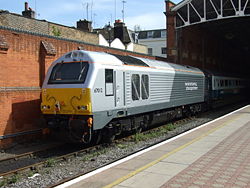
In the 1990s, upon rail privatisation in 1996[10], the station was given an even bigger boost when Chiltern Railways took over the rail services. Chiltern trains made the station the terminus for a new intercity service to Birmingham's Snow Hill station. To cope with Chiltern Railways' success over the last ten years and to cope with increased passenger numbers, a new platform (platform 6) opened in May 2006. This was part of Chiltern's £70-million project Evergreen 2. Platform 5 and the shortened platform 4 opened in September 2006. The canopies on platforms 5 & 6 were built in a similar style to the canopy on the original platform 4, which was demolished in the 1980s. Additionally, a new depot has recently opened near Wembley Stadium railway station to compensate for the closure of Marylebone's station sidings and to make way for the new platforms. To highlight Chiltern's success, some services from Marylebone have also now been extended beyond Birmingham to Kidderminster. Success has been so great that Marylebone now serves more passengers than use the purely domestic services at St Pancras.
In late January 2006, a new company called the Wrexham, Shropshire and Marylebone Railway (WSMR), was formed. In September 2007, the Office of Rail Regulation granted the company, trading as Wrexham & Shropshire permission to operate services from Wrexham (in North Wales) via Shrewsbury, Telford and the West Midlands to Marylebone, which started from early 2008. This restored direct services to London from Wrexham and Shropshire.
The main line leads out of the station northwards, immediately passing under Rossmore Road (from which the carriage road used to descend); over the Regent's Canal; and into a long series of cut-and-cover tunnels, crossing the LNWR main line from Euston at right angles and eventually turning sharply north-west to emerge at the south side of the West Hampstead rail complex.
Future
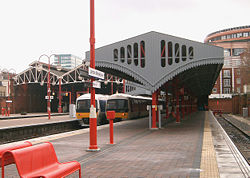
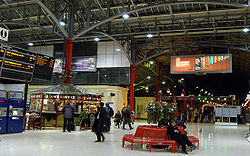
Chiltern Railways have suggested that it wants to reopen the Great Central Main Line north of Aylesbury to Rugby [1] and, if successful, Leicester. The possibility of reopening the line between Princes Risborough and Oxford has also been examined. This would give Oxford an additional rail link to London, which could be faster than the current one, although this was not a franchising commitment. Chiltern Railways has also hinted that it may connect to Oxford by building a new line at Bicester to connect the Chiltern Main Line with the Varsity Line [11].
Therefore, in the future, it is possible that Marylebone may not only serve the West Midlands, Oxfordshire and Buckinghamshire but also North Wales, Shropshire, Northamptonshire and Leicestershire.
It is possible that in the future a new station may be constructed on the main line out of Marylebone. There is currently a large gap North of Marylebone until trains reach either Wembley Stadium or Harrow-on-the-Hill station. The station is most likely to be located at West Hampstead[12]. It could be made an interchange with the Metropolitan Line, which also has a large gap between stations. However, this would require an amendment to the Act of Parliament for the railway, which committed the Great Central to not competing with the Metropolitan by providing adjacent stations, in return for which the Met allowed the GCR to shadow their line and use their tracks for the run into Marylebone.
Services
Monday-Friday (off-peak)
- 2 trains per hour (tph) to/from Aylesbury (via Amersham)
- 2tph to/from Birmingham Snow Hill (fast)
- 1tph to/from High Wycombe (slow)
- 1tph to/from Bicester North or Stratford-upon-Avon (semi-fast)
| Preceding station | National Rail | Following station | ||
|---|---|---|---|---|
| Terminus | Chiltern Railways Chiltern Main Line semi-fast services |
Gerrards Cross | ||
| Chiltern Railways London - Aylesbury |
Harrow-on-the-Hill | |||
| Chiltern Railways London - High Wycombe stopping services |
Wembley Stadium | |||
| Terminus | Chiltern Railways Chiltern Main Line fast services |
High Wycombe | ||
| Terminus | Wrexham & Shropshire London-Wrexham |
Banbury (Pick-up northbound Set-down southbound) |
||
Station Facilities
The station concourse contains a small selection of shops, two notable examples being Marks and Spencer and WH Smiths. Toilet facilities have recently been refurbished[13] and their usage is free of charge.
London Underground
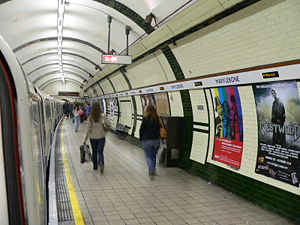 |
|
| Location | Marylebone |
|---|---|
| Local authority | Westminster |
| Managed by | London Underground |
| Platforms in use | 2 |
| Travelcard zone | 1 |
| LUL 2006 usage | 9.804 million[14] |
| LUL 2007 usage | 10.801 million[14] |
|
|
|
| 1907 1907 |
Opened as temporary terminus (BS&WR) Service extended (BS&WR) |
|
|
|
| List of stations | Underground • National Rail |
The underground station is served by the Bakerloo Line. It is between Baker Street and Edgware Road stations and is in Travelcard Zone 1. Access is via a set of escalators from the mainline station concourse, which also houses the underground station's ticket office.
Compared to some of the other London termini, the mainline station's Underground links are poor. This is because the mainline station was opened thirty-six years after the Metropolitan Railway constructed the first part of what is now the northern section of the Circle Line which by passes the station to the south.
For mainline passengers wishing to use services on the Circle, Hammersmith and City or Metropolitan Lines, it may often be quicker to walk the short distance to nearby Baker Street station, than to make the journey on the Bakerloo Line and change trains there: especially since the Bakerloo is further underground than the Circle, Metropolitan and H&C lines.
History
The underground station opened on the 27 March 1907 under the name Great Central, and was renamed Marylebone on the 15 April 1917.[15] The original name still appears in places on the platform wall tiling, although the tiling scheme is a replacement designed to reflect the original scheme.[16]
The present entrance opened in 1943 following the introduction of the escalators and wartime damage to the original station building that stood to the west, at the junction of Harewood Avenue and Harewood Row. This building, designed by the Underground Electric Railways Company's architect, Leslie Green, had used lifts to access the platforms. It was demolished in 1971 and the site is now occupied by a budget hotel.
| Preceding station | Following station | |||
|---|---|---|---|---|
|
Edgware Road
towards Harrow & Wealdstone
|
Bakerloo line |
Baker Street
towards Elephant & Castle
|
Gallery
In popular culture
- In 1964 several scenes in the Beatles film A Hard Day's Night were filmed at Marylebone station.
- The station appeared in an episode of Magnum PI while the series was filmed around London.
- The station appeared in The IPCRESS File.
- The station appeared in the BBC's spy drama Spooks, season 4, episode 1. The script pretended that it was Paddington.
- The station appeared in the hit BBC Comedy Gavin & Stacey recently, branded as London Paddington.
- The station appeared in the Dempsey and Makepeace episode 'Judgement'.
- The station appeared in the final episode of series 2 of Green Wing.
- The station also has a degree of fame because of its presence in the British version of Monopoly.
- The station was used as a location for an episode of Peep Show Series 4
- The station appeared in the Doctor Who serial, Doctor Who and the Silurians.
- The station appeared in an ITV advert for the UEFA Euro 2008 football championships.
Notes
- ↑ 1.0 1.1 1.2 Annual passenger usage based on sales of tickets in stated financial year(s) which end or originate at Marylebone station from Office of Rail Regulation statistics
- ↑ http://www.experiencefestival.com/a/1899_in_rail_transport_-_Events/id/4732809
- ↑ Braddock was the son of a stone carver from Bolton, Lancashire. As a civil engineer he had been employed on the Mersey railway tunnel, but returned to London, where he had been living with his wife Selina, following completion of the project. His son was Tom Braddock (1887-1976), Labour M.P. Palgrave, p. 23
- ↑ The terminus was described and illustrated by G.A. Hobson and E, Wragge, "The Metropolitan Terminus of the Great Central Railway", Minutes of the Proceedings 143 (1901.1) pp 84ff; the volume also contains a round-robin discussion of the Terminus, in which Braddock was not included.
- ↑ http://www.experiencefestival.com/a/Marylebone_station_-_National_Rail/id/5280492
- ↑ http://www.greatcentraltoday.com/gcrhistory.htm
- ↑ http://www.greatcentraltoday.com/gcrhistory.htm
- ↑ http://www.greatcentraltoday.com/gcrhistory.htm
- ↑ http://www.greatcentraltoday.com/gcrhistory.htm
- ↑ http://www.atoc-comms.org/franchised-passenger-services-chiltern-railways.php
- ↑ Chiltern Railways plan to make Bicester well connected Accessed 2008-09-04
- ↑ "West Hampstead Interchange". alwaystouchout.com (2006-01-11). Retrieved on 2008-06-06.
- ↑ "New Toilet Facilities open at Marylebone".
- ↑ 14.0 14.1 Transport for London - London Underground performance update
- ↑ Rose, Douglas (1999). The London Underground, A Diagrammatic History. Douglas Rose/Capital Transport. ISBN 1-85414-219-4.
- ↑ Rose, Douglas. "Great Central". London's Underground Edwardian Tile Patterns. Retrieved on 2008-01-13.
See also
- The Landmark London - the present name of the former Great Central Hotel
External links
- Train times and station information for Marylebone railway station from National Rail (Station code: MYB)
- Marylebone Station at Chiltern Railways
- Marylebone station is at coordinates
|
|||||||||||
|
|||||||||||||||||||||||||
|
|||||

